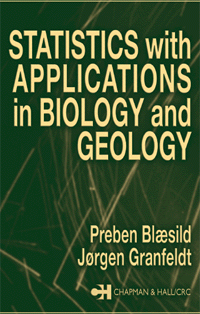Example
7.1
Mendel's pea data. The data are used to illustrate the test of a simple
hypothesis in the multinomial distribution as well as the test of
independence. |
Example
7.2
Esterase types in eelpouts. |
Example
7.3
Connection between the shape of a stone and its weight. |
Example
7.4
Pesticides in water. |
Example
7.5
Data from a case-control study to investigate whether children
living close to a high-voltage transmission line have an increased
risk of cancer. The data are used to illustrate Fisher's exact test.
|
Example
7.6
The recordings of heights of 247 girls in Example 2.1 used to illustrate
the goodness of fit test.
|
Example
7.7
Mother-offspring combinations of esterase types from a genetic survey
of eelpouts conducted at the University of Aarhus. 782 pregnant eelpouts
were caught at Kaloe Cove in 1969. By electrophoresis three esterase
types of eelpouts - denoted 1, 2, and 3 - are found. For each mother and one of her offspring the
esterase type was determined.
|
Exercise
7.1
The distribution of 132 radishes according to shape and color is investigated.
|
Exercise
7.2
The fur color of a cat is categorized as either Dark, Medium,
or Light corresponding to the genotypes AA, Aa,
and aa. All cats on a small island were caught. The genotypic
frequencies among the 180 female cats are shown to be in Hardy-Weinberg
proportions. The fur color Medium was not observed by any
of the 155 male cats, which indicates that the gene is positioned
on the cats X chromosome. It is shown that frequency of the
A allele is the same for males and females. |
Exercise
7.3
A particular gene in the beetle Tetraopes tetraophthalmus
has three codominant alleles A, B, and C.
Consequently, there exist six different genotypes AA, AB,
AC, BB, BC, CC. These six genotypes
may be distinguished by electrophoresis also giving six phenotypes.
From a population on Long Island, 287 beetles were collected and classified
according to genotype. |
Exercise
7.4
The data consist of 21 and 31 samples of ground water taken in 1990-1991
from the northern part and the southern part of the county of South
Jutland, respectively. For each of the samples it was investigated
if the recommended limit value µg/l for concentration of Barium
100 was exceeded. The results for the two parts of the county are
compared. Furthermore, the results are compared with the results from
a similar investigation in the county in 1995-1996. |
Exercise
7.5
The data consist of the number of waterworks with a yearly production
larger than 10000 m3 in some of the counties in Denmark together
with the number of waterworks for which at least one of the limit
values, as laid down by the Danish Ministry of Environment and Energy,
for the parameters NO3, Cl, Na, K, and F has been exceeded.
For four groups of counties it is shown that the probability of exceeding
the limit value may be assumed to be thev same with the groups, but
that it varies from group to group. |
Exercise
7.6
When a botanist wants to determine how frequently a particular plant
occurs on a locality, he often uses a method known as Raunkiœr
circling. Within a sample site $n$ circular plots of the same
area are placed at random positions and the number of plots where
the plant occurs is counted. The plots are referred to as Raunki\ae
r circles, hence the name of the method.
The data are from a larger investigation on the occurrence of marsh
thistle, Cirsium palustra, at various locations in different
geographical areas of Jutland. It is shown that it may be assumed
that the marsh thistle occurs with the same probability in each locality
within an area, but that the probability varies from area to area.
|
Exercise
7.7
The data are from an experiment with recapture of 2- to 3-year-old
sea trouts (Salmo trutta). At 5 stations a number of trout
were released after being marked with a marker that identified the
station. Some of the fish were caught again in a net. In the exercise
is it investigated whether the probability of recapture is the same
for the 5 stations. |
Exercise
7.8
The data are from a study of the migration behavior of the green toad Bufo viridis. 4 toads were watched closely for 17 days and
19 nights and the number of migrations undertaken by the toads were recorded.
In 10 of the 17 days and in 7 of the 19 nights there was rainfall.
It is examined whether and how the precipitation (rain/dry) and time
(night/day) influence the probability of migration. |
Exercise
7.9
Mother-offspring combinations of esterase types from a genetic survey
of eelpouts conducted at the University of Aarhus. The exercise is
concerned with the same data and the hypotheses that are considered
in Example 7.7 on page 333. |
Exercise
7.10
In this exercise the data and the hypotheses of Example 1.1 on page
1 are considered in more detail than was feasible in the introductory
chapter. |
Exercise
7.11
Data from an investigation of the criminality of twins. |
